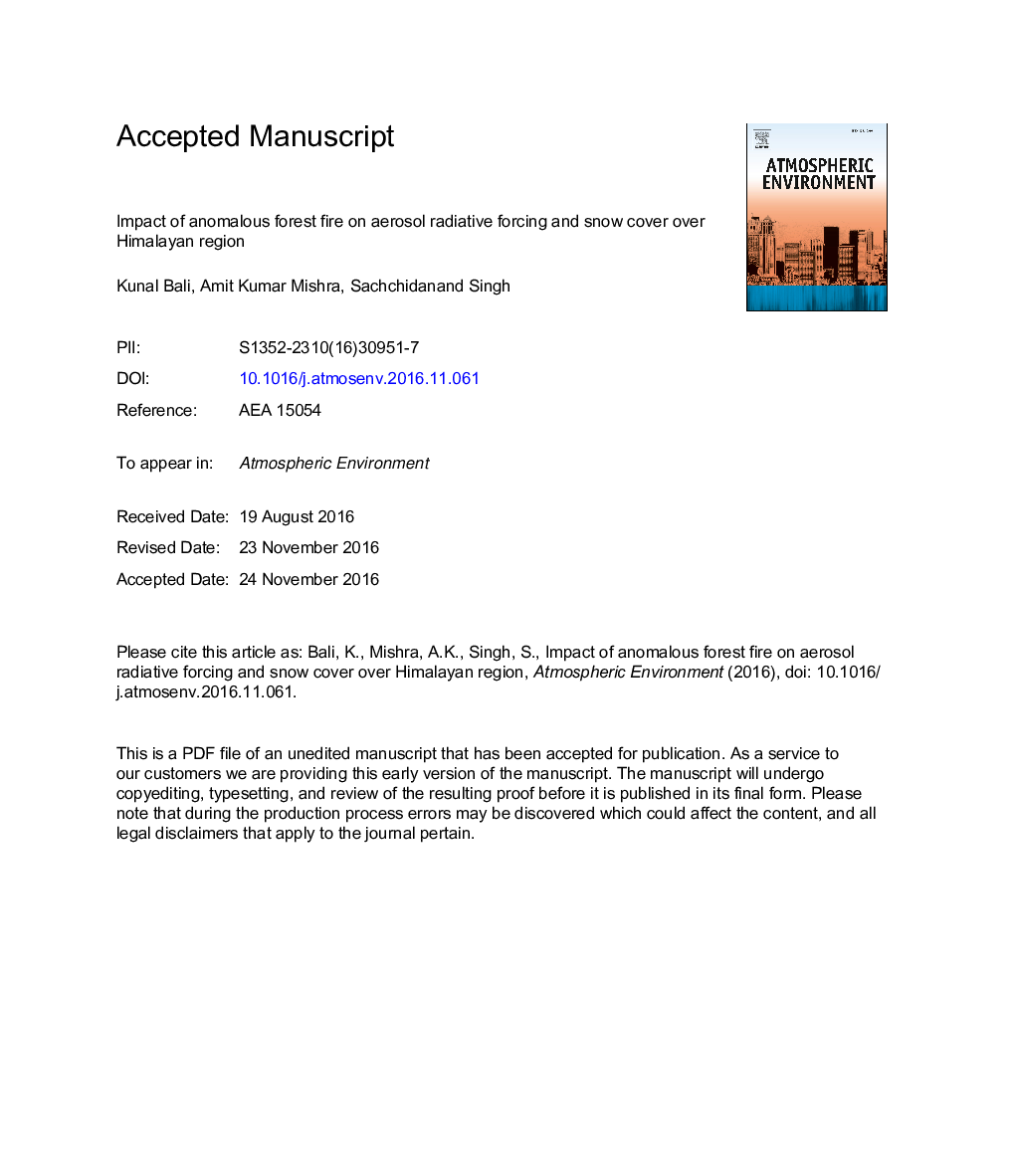| کد مقاله | کد نشریه | سال انتشار | مقاله انگلیسی | نسخه تمام متن |
|---|---|---|---|---|
| 5753463 | 1620324 | 2017 | 42 صفحه PDF | دانلود رایگان |
عنوان انگلیسی مقاله ISI
Impact of anomalous forest fire on aerosol radiative forcing and snow cover over Himalayan region
ترجمه فارسی عنوان
تاثیر آتش سوزی غیرمعمول بر تیراندازی تابشی آیرزل و پوشش برف در منطقه هیمالیا
دانلود مقاله + سفارش ترجمه
دانلود مقاله ISI انگلیسی
رایگان برای ایرانیان
کلمات کلیدی
آتش سوزی جنگل، سوختگی زیست توده، کربن سیاه، کربن ارگانیک، تیره شدن سطح هیمالیا
موضوعات مرتبط
مهندسی و علوم پایه
علوم زمین و سیارات
علم هواشناسی
چکیده انگلیسی
Forest fires are very common in tropical region during February-May months and are known to have significant impact on ecosystem dynamics. Moreover, aerosols emitted from these burning activities significantly modulate the Earth's radiation budget. In present study, we investigated the anomalous forest fire events and their impact on atmospheric radiation budget and glaciated snow cover over the Himalayan region. We used multiple dataset derived from satellites [Moderate Resolution Spectroradiometer (MODIS) and Cloud-Aerosol Lidar and Infrared Pathfinder Satellite Observations (CALIPSO)] and reanalysis models [Global Fire Assimilation System (GFAS), Second Modern-Era Retrospective analysis for Research and Application (MERRA-2) and ERA-interim] to evaluate the effect of biomass burning aerosols on radiation budget. April 2016 is associated with anomalous fire activities over lower Himalayan region in the last fourteen years (2003-2016). The model estimated organic carbon (OC) and black carbon (BC) emission reaches up to â¼3 Ã 104 and â¼2 Ã 103 μg/m2/day, respectively during the biomass burning period of April 2016. The meteorological data analysis accompanied with CALIOP aerosol vertical profile shows that these carbonaceous aerosols could reach up to â¼5-7 km altitude and could be transported towards glaciated region of upper Himalayas. The large amount of BC/OC from biomass burning significantly modulates the atmospheric radiation budget. The estimated columnar heating rate shows that these carbonaceous aerosols could heat up the atmosphere by â¼0.04-0.06 K/day in April-2016 with respect to non-burning period (2015). The glaciated snow cover fractions are found to be decreasing by â¼5-20% in 2016 as compared to long term mean (2003-2016). The combined analyses of various climatic factors, fires and associated BC emissions show that the observed snow cover decrease could be results of increased surface/atmospheric temperature due to combined effect of large scale climatic changes and BC absorption. Our results suggest that biomass burning can have significant effects on the Himalayan region, particularly in view of its importance in hydrological cycle and ecosystem.
ناشر
Database: Elsevier - ScienceDirect (ساینس دایرکت)
Journal: Atmospheric Environment - Volume 150, February 2017, Pages 264-275
Journal: Atmospheric Environment - Volume 150, February 2017, Pages 264-275
نویسندگان
Kunal Bali, Amit Kumar Mishra, Sachchidanand Singh,
